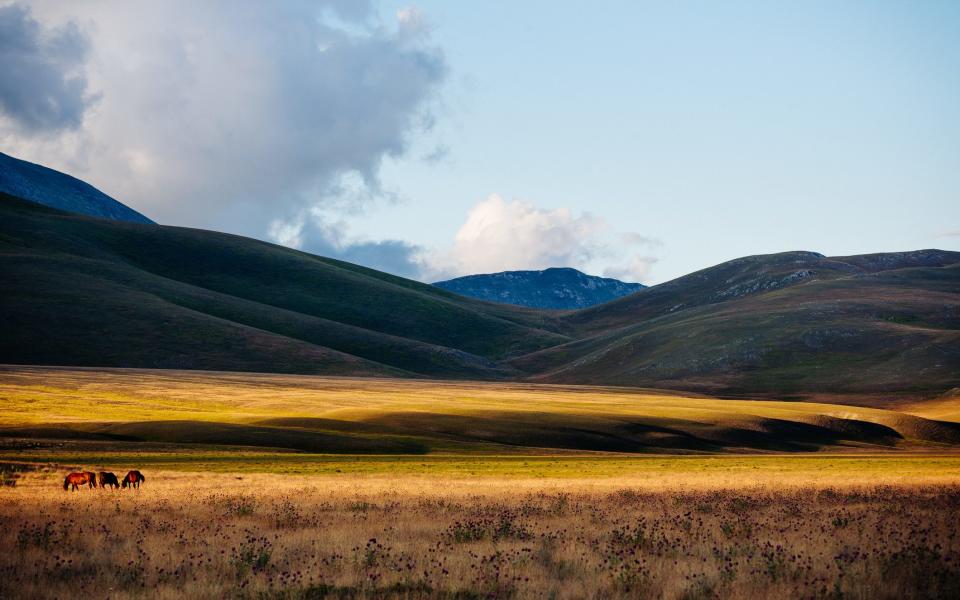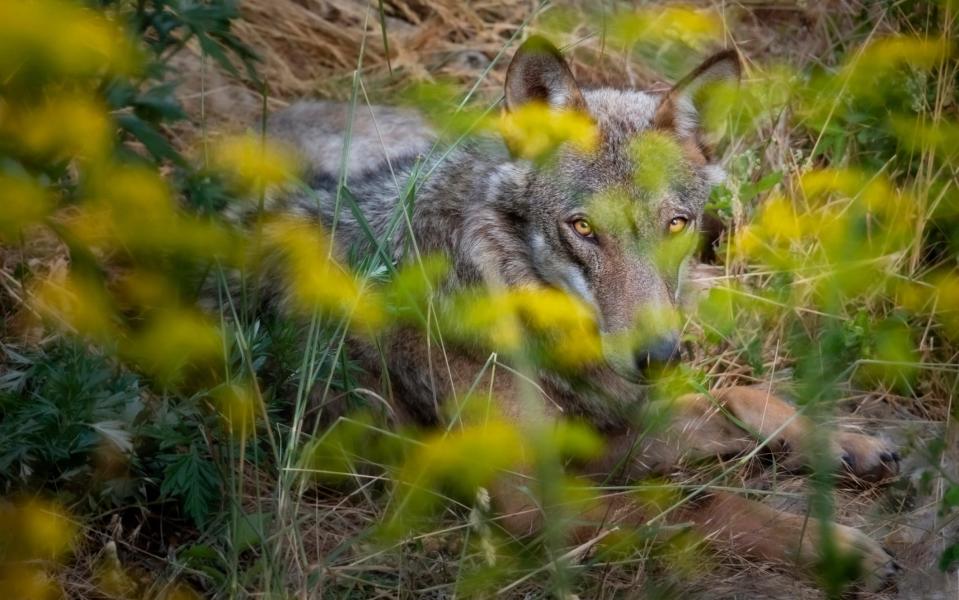Italy has welcomed visitors ever since. But not all of Italy: certain regions are still impervious to the Grand Tourists of the past and the Instagrammers of today. Who, for example, visits Abruzzo, a region east of Rome and south of the Marche?
The answer is little – but why so secretive? Poverty, for one thing, and the sheer wilderness of the mountains for another. The region was too high and isolated for vines and olives, and the medieval trade and rich history that nurtured the cities – and art – of Tuscany, Umbria and Sicily.
And yet things are changing now, albeit slowly (houses can be found here for less than €10,000). Travelers are learning at last that her mountains, still inhabited by wolves and bears, are the best in Italy outside the Alps, that her coast is wonderfully wild in places, and that many of her ancient villages timeless and traditional in the best sense. And if the visitor infrastructure is still in its infancy – part of the region’s charm, of course – newer destination hotels are gradually opening, and the food, as always in Italy, is excellent.
The new Tuscany? The new Umbria? Not enough. But a place to visit now before everyone else? Definitely.
The landscapes
Glorious mountain landscapes are the main attraction of Abruzzo. The Apennines – the rocky spine of the Italian peninsula – reach their highest point here in the peak of the Gran Sasso (9,553ft/2,912m), which is still home – just – to one of the southernmost glaciers in Europe.


Gran Sasso is also the name given to one of three massifs in the region, the other two being the Monti della Laga to the north and the Maiella to the south. All three have national park status, as does the fourth enclave, the Parco Nazionale d’Abruzzo on the western flanks of the region.
For those who know only the most benign aspect of the Apennines in Tuscany, Umbria or Liguria, it is difficult to understand the scale of the Abruzzo mountains or their wild innocence. Wolves and even bears still roam here and large, beautiful parts of the region can only be reached on foot, following ancient cross-country trails, or with a patient – but very worthwhile – odyssey on high mountain roads.


Most people visit the Parco Nazionale d’Abruzzo, partly because it is the closest to Rome (81 miles/130km via the A2 motorway and the towns of Frosinone and Sora) and partly because it is one of the best managed national parks in Italy. You’ll also find more hotels, facilities and marked cycling and hiking trails here, especially in the main centers of Pescasseroli and smaller Opi, as well as pretty medieval Scanno just outside the park’s borders.
In the Monti della Laga, travel on the beautiful road between Acquasanta Terme (directly in the Marche) and Teramo, and consider the village of Pietracamela as a base. From here you can easily go south and take one of the best drives in Europe, not to mention Italy: the road that runs east to east under the Gran Sasso across the great upland plains of the Campo Imperatore, later known as “Little Tibet”. its a great view.


Visit Castel del Monte, one of the most beautiful villages in the region, located well above 4,000 feet. This is also a good place to stay, but drive a few miles and the tiny Santo Stefano is home to one of the most interesting hotels in central Italy, the Sextantio (doubles from around £150 including breakfast).
Or, if you’re heading for the coast (see below), continue east to Farindola, a small Abruzzese village with great views and a great food selection (see below). Be sure to spend an hour or so in Loreto Aprutino to the east, one of the most attractive medieval villages in the region.


Explore the third part of the Abruzzo massif, the Maiella, and you’ll be entering one of the last great deserts in Western Europe. There are few places to stay in the heart of the mountains, and Caramanico Terme is your best bet, but Sulmona just to the west is the larger and most interesting town of Abruzzo, the birthplace of Ovid and sugared almonds, or confetti (Sulmona almonds were served at Harry’s Wedding and Meghan).
It’s a town worth visiting in its own right, especially if you can be here on a Wednesday or Saturday morning, when Piazza Garibaldi has a great market. It is also on a railway line – and there are not many of those in this mountain area: the journey here from Rieti via L’Aquila, and especially on to Castel di Sangro and beyond, is one of the most beautiful in Italy.


The holidays and beaches
Mountains take the most praise in Abruzzo but the long coast of the region is another attractive subject. Many of the beaches and resorts are typical of the Italian east coast, Adriatic, that is to say they are small family businesses, often close to the main rail and road links of the coast, and with decent if not decent sand and hotels. they are amazing.
Although there are some spots in the north that are fairly workable, there are two notable exceptions: the wild, glorious pieces of sand in the Riserva Naturale del Borsacchio, north of Roseto degli Abruzzo, and Torre del Cerrano near Pineto, named after the historic defense in nearby. tower
South of Pescara, visit Punta Ferruccio near Ortona – the site of a bitter battle in 1943: it is not easy to reach, but worth the effort, and there are clothing-optional stretches. The nearby Calata or Spiaggia del Turchino is equally wild and beautiful near San Vito Chietino, where the contemporary hotel Le Chiave dei Trabocchi makes a fine base (doubles from around £60).
This part of the coast gets its name from the very beautiful trabocchi, the wooden walkways and the fishing shacks built on stilts that are unique to the region.


A few miles further south, the Lido di Casalbordino is another pilgrimage point for beach lovers, with the simple Finis Terrae bar a prime spot to watch the sunset. Two other beaches stand out close to Vasto, the last hurray of Abruzzo before the border with Molise: Punta Penna and Punta Aderci. Both are wild places partially protected by nature reserves.
Abruzzo also has a number of family-friendly Green Flag beaches.


The food and wine
Like much else in Abruzzo, the region’s food is hardly known but often exceptional. The coast has predictably good fish and seafood, especially the mussels (cozze) from Vasto, often served with saffron (its own regional specialty) or stuffed with breadcrumbs, lemon, parsley, garlic and tomato sauce.
The classic pasta is maccheroni alla chitarra, a spaghetti-like creation made by pushing sheets of pasta through strings (hence chitarra, or “guitar”).
When all is said and done, however, Abruzzo is a mountainous region, and it is the mountains, and the centuries when poverty was the culinary mother of invention, that color the region’s cuisine the most.
There are plenty of mushrooms and truffles, as well as pulses and beans, but lamb and mutton were and are the staple of mountain cooking. One of the great meals of the region – one of the great meals of Italy – can be found up on the high plains of the Campo Imperatore and elsewhere (see above).
A remote, windswept shack of shepherds will sell you a bundle of bread, some roughly chopped pieces of pecorino (sheep’s cheese) and a handful of arrosticini – skewers loaded with small pieces of lamb and mutton – which you (or they) grill open. fires. Eat with your fingers and ask for nothing more.


Arrosticini are a staple of many mountain villages, too – make a pilgrimage to Farindola and Lu Strego, a trattoria that has been named the best in Abruzzo more than once.
Wine-wise, no one goes to Abruzzo to tour the region’s vineyards – for the most part the mountains don’t help grow vines – but wherever you go you’ll be able to drink Montepulciano d’Abruzzo, Another red-hot thing you’ve probably come across at home. Trebbiano is the standard white, although a lighter red Cerasuolo is also made from the Montepulciano grape.
But there is quality. As elsewhere in “lesser” Italian wine regions such as Umbria, in the post-war period newer, more dynamic producers were now pioneering some excellent wines. Look especially for bottles from Pepe and Valentini, along with CantinArte, Annona, Italo Pietrantoj, Cataldi Madonna and Valle Reale.
For more unusual regional drinks, risk a glass of ratafia, a black cherry liqueur; Aurum, an orange-scented brandy made in Pescara since 1925; centerbe (literally “first herb”), made from the mountain herbs of the Maiella; and genziano, made from the root of the caraway.
Go there
Ryanair flies to Pescara Airport from Stansted. There are many more options if you fly to Rome, from which the regional capital L’Aquila is a 90 minute drive.
Staying there
Villa companies as a whole are still feeling their way into Abruzzo – usually a company may only own one or two properties in the region – but check out the dedicated Abruzzo Turismo page or the properties listed on the Vrbo site (formerly HomeAway) by owners. For more ideas on where to stay, check out our guide to the best hotels in Abruzzo.
This story was first published in March 2022 and has been revised and updated.